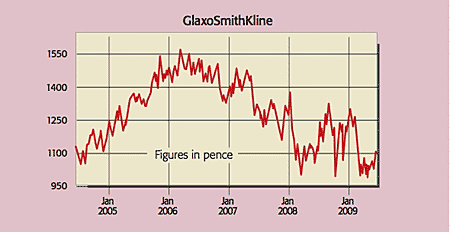
In terms of investors’ lack of interest, low valuations and high yields, you can’t beat utilities. But plenty of other defensive sectors and stocks still look attractive for those seeking a diverse range of income stocks. Take pharmaceuticals. The sector has fallen out favour with investors over the past decade, and now the prospect of US healthcare reform, which could hit future profits, has been taking its toll on pharma share prices too.
Investors fret that “expiring patents will put pressure on billions of dollars of blockbuster drug sales over the next few years”, says the FT’s Lex. “Yet the industry has been in a similar position before”. Drug makers pulled through the 1960s and 1970s “when research productivity plummeted” by creating “a series of new blockbusters and two decades of bumper profits”.
What’s more, drug firms are still very good at churning out cash. Over the last year, the world’s top ten drug makers by revenue have produced over $78bn of free cash flow. Today, says Lex, “most big drug groups are well-run businesses with strong cash flows and solid long-term prospects – just the kinds of companies that strategic investors with an eye to the future should like”.
Yet since 9 March, when global stockmarkets began their recent rally, the MSCI World Pharmaceuticals index has undershot the MSCI World index by 14%. And the longer-term picture is quite staggering. Citigroup’s European equity strategy team has looked at the historic p/e for the UK pharma sector going back to 1965.
On several occasions, company valuations have hit the upper 20s, and at the end of the last century climbed to p/es of almost 50. Now, “valuations are back to 1970s levels”, says Citigroup. As the FT puts it, the FT 350 Pharmaceuticals & Biotechnology index trades at just 8.5 times forward earnings, compared with the past decade’s average forward multiple of 18 times.
So what should you buy?
GlaxoSmithKline (LSE: GSK) is on a current year p/e of 9.6, which is forecast to fall to 9.4 in 2010, and a 5.5% yield that’s predicted to rise to 5.8% next year. And if Glaxo looks good, what about AstraZeneca (LSE: AZN)? This well-diversified research and manufacturing operation is even better value in valuation terms on a 2009 8.5 times multiple, with a forward yield of nearly 5%.
There’s also a strong defensive case for holding something completely different – tobacco stocks. So-called ‘vice’ stocks, which include tobacco and gambling, have a good track record of performing during recessions. In fact, they have beaten the S&P 500 index by an average of 12% over the past six recessions, according to analysts at Merrill Lynch.
So assuming you aren’t put off by the ethical issues around the sector, British American Tobacco (LSE: BATS) looks good. Over the long term, it has easily outshone the overall UK market indices in terms of performance. Yet it’s still a relatively cheap share, despite its ongoing ability to produce strong cash flow. On a current year p/e of 11.6, predicted to fall to 10.8 next year, and a 5.5% 2009 yield, which is set to rise to 6% in 2010, the group remains a great value stock with a strong track record.
Meanwhile, across the Atlantic, Altria (NYSE: MO) is by some way America’s biggest tobacco group. If it’s not a name you know well, you’ll probably have heard of Philip Morris, which produces almost 75% of Altria’s earnings. The group trades on a p/e of 9.5 for this year, falling to a forecast p/e of nine next year, and an 8%-plus forward yield.
Staying in the US, here’s one more defensive stock that we mentioned last month that has so far done nothing – the telecommunications company Verizon (NYSE: VZ). “If you don’t own Verizon, you shouldn’t be allowed to call yourself an investor”, says Porter Stansberry on Dailywealth.com. “The firm’s $40bn fibre network will dominate the flow of data in the US for at least the next 50 years”.
But you don’t have to be as bullish as Stansberry to appreciate that a forecast p/e of 11 for next year, combined with a very solid 6.4% forward yield, is exactly what you’ll want to be locked in to when the markets start to wobble again.